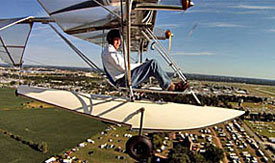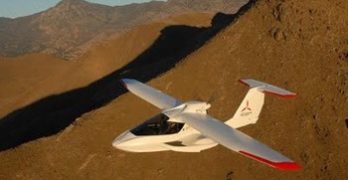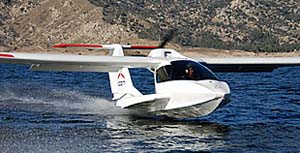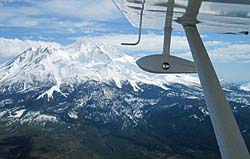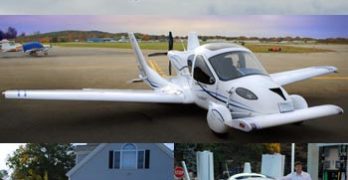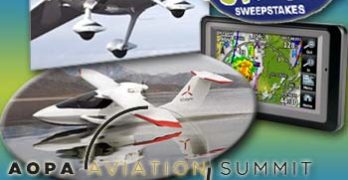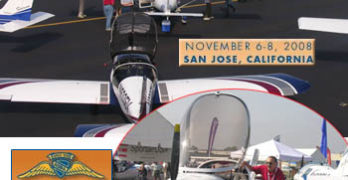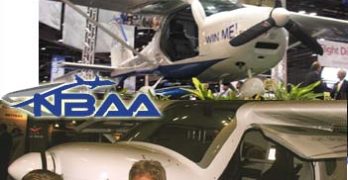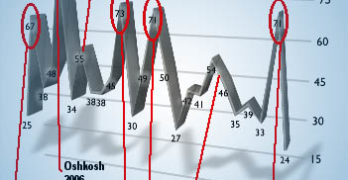Reports continue positively for results at AirVenture 2011… despite FAA’s partial shutdown, a media frenzy over the USA’s debt ceiling, a roller coaster ride in the stock markets, and a continuing bum housing market plus general uncertainty. If you can smile after all that, things must be improving. *** GAMA’s report of Type Certified aircraft deliveries for the first half of 2011 shows sales remain far below manufacturing capacity. Thanks significantly to Cessna’s hastened deliveries of Skycatcher, the LSA sector is surviving a bit better; of course, LSA sell many less units than GA and account for much smaller dollar volume. Here’s more evidence of improvement… •• Icon Aircraft announced they secured 143 delivery position sales ($286,000 raked in) at AirVenture for their sexy new A5, expected on the market perhaps by 2012. Icon generously donated 10% of the take to EAA Young Eagles program. •• Flight Design continues to log orders for its LSA but their new four seat C4 has now garnered nearly 100 delivery position orders (at $7,000 apiece).
Search Results for : Icon A5
Not finding exactly what you expected? Try our advanced search option.
Select a manufacturer to go straight to all our content about that manufacturer.
Select an aircraft model to go straight to all our content about that model.
AirVenture 2011 Wrap-Up and Summary
Oshkosh 2011 is history. By numerous accounts, this was a vast improvement over 2010 when the comments commonly went, “Well, I had some interest (in my airplane) and I hope to sell one or two… maybe.” This year I had easily 30 conversations revealing either outright positive successful results or varyingly robust mood indicators such as, “Looks like aviation has life in it again.” I heard from sellers and customers and rarely had to solicit their opinions. *** A number of aircraft purveyors said they took cash deposits and wrote firm contracts. I estimate about 30 aircraft sales by this method. Companies like Icon, Flight Design, and Terrafugia sold a large number of future delivery positions (more than 50, more than 60, and “several,” respectively). *** Icon neared or crossed the 500-on-order point, partly by “testing elasticity” in the pre-order market by lowering the A5 seaplane deposit to $2,000 from $5,000.
Of Amphibs and Aircars
Two of the best-promoted and most interesting LSA projects – and two of the most delayed getting to market – are back in the news. Icon Aircraft, a startup company created to produce the sexy composite A5 amphibian, just snagged $25 million in funding to help complete remaining design issues, tool up for production and begin cranking out airplanes. *** The company reports around 500 A5 orders on the books, at $139,000 per. A few months of flight testing remain to be completed, along with a new wing (reportedly for better spin resistance and directional stability), which means the production target date has been pushed back again, this time to the last quarter of 2012. *** Reported among the new crop of investors are Eric Schmidt of Google, Satyen Patel, formerly of Nike and Phil Condit, former CEO of Boeing, and some “undisclosed” Silicon Valley entrepreneurs. The initial infusion of greenbacks will be $15 million, with an option for $10 million more.
What Does It Take to Develop a SLSA? $25+ Million?
Most of the 118 Special Light-Sport Aircraft have been developed on a very modest budget… not that there’s anything wrong with that, of course. By far, the highest figure I’ve heard was about $2 million to create a new SLSA model. Yet that number doesn’t include starting a company from scratch and going all the way through to a new production facility with airplanes ready to fly away. So, what’s the total investment? Well, that depends on a thousand variables. It can be done quite inexpensively. Or, you can shoot for the moon. *** “Icon Aircraft recently closed a $25 million round of U.S. and U.K. venture financing from several high-profile consumer-product and aviation investors,” the company announced today. “The [money] takes Icon through the completion of the A5 development program and into the production phase.” *** So, one thing seems certain. Before gaining SLSA status or building a single production airplane, Icon is already the LSA market leader… in fund raising.
SeaMax Illustrates a Point About Niche LSA
One of the oft-repeated questions about this new thing called Light-Sport Aircraft is: “When will the shakeout occur? When will some of these 75 companies [who certified a SLSA] disappear… and which ones will fail?” *** First, my ability to see the future is no better than anyone else. We’ve lost a few suppliers (Taylorcraft, Urban Air, Spain’s CAG, Higher Class). But as a longtime observer of many sport aviation segments, here’s my view: (1) The current market leaders — the top dozen or so — will likely remain as they’ve already proven themselves. Remember, many overseas brands have world markets so they don’t rely 100% on U.S. sales. And should they fail, it will most likely be due to business practices, not their aircraft design. A few newcomers will enter the top ranks, including such legacy brands as Cessna (which has presently delivered so few Skycatchers that the giant manufacturer is not yet in the Top 20).
Ticket to Ride… er, Fly… Well, Both… Maybe
You’ve surely seen news coverage of Terrafugia’s Transition, the “roadable” LSA from a brain trust of award-winning MIT engineers in Woburn, Massachusetts. This modern version of the well-worn flying car concept has attracted plenty of media attention, and deservedly so, I think. I have been reviewing all their materials and info for an article to appear in Light Sport and Ultralight Flying magazine and I’m impressed with the task’s complexities. *** Step one is the effort to create a powered-folding-wing, four-wheel aircraft that flies as the designers wish. That’s hardly a trivial project especially as the folding wing must work in such a way that you can then drive down the road without removing those wings. (In comparison, Icon’s A5 also has powered folding wings but they stay full length, sweeping back against the seaplane’s fuselage.) *** Step two is making a road-capable drive train using the same Rotax 912 powerplant.
AOPA Summit 2009 Broadens Outreach of LSA
In its first year as the AOPA “Summit” (versus “Expo”), the 70-year-old, 415,000-member organization made lots of changes large and small. Among the most notable under capable new president Craig Fuller was much greater attention to LSA. Here’s the fast-read update… *** AOPA announced their 2010 Sweepstakes airplane is a Remos GX; the company had multiple displays and aircraft. Cessna brought a Skycatcher for selected reporters to fly. Craig Fuller had Icon A5 developer Kirk Hawkins on the center-hall stage. EAA’s Earl Lawrence led a LSA panel of FAA and industry experts (including yours truly). LAMA operated an LSA Mall area and had fruitful discussions with AOPA to advance goals of the LSA industry. SeaMax USA showed off their simulator seaplane running on MS Flight Sim. Tecnam North America, with several aircraft on display, announced new service centers for the popular Italian line of aircraft they now represent.
LSA on their Way to San Jose (AOPA Expo)
Everyone is talking about tough economic times and aviators note the effect on the LSA and GA industries. But that won’t stop a good selection of Light-Sport Aircraft from appearing at AOPA’s annual Expo, this year in San Jose, California over November 6-7-8. In fact, with 60+ display airplanes expected and 14-15 of them LSA (list below photo), the light sector once again has a strong presence. *** Thanks to cooperation from AOPA static aircraft display organizers, LSA will once again be presented largely as a group (think LSA Mall). And the location for the collected LSA is sweet indeed: immediately inside the entryway to AOPA’s static aircraft display at Norman Mineta airport. You won’t be able to miss the LSA collection, so come on out and do a little shopping. *** In addition to aircraft displays, AOPA offers a wide range of seminars, including two presentations I will give called, “State of the Light-Sport Aircraft Industry” (TH-11/6 and SA-11/8, both at 11 AM to noon).
Hanging with the Jet Crowd; LSA at NBAA
Earlier it appeared that the Flight Design MC would be the first Light-Sport Aircraft ever displayed at the giant National Business Aircraft Association show. NBAA is the organization representing business jets plus a large range of exhibitors serving executive transportation. The trade show happening now in Orlando is a stupendous event with many more exhibitors than Oshkosh. Numerous displays are fantastic creations that cost more for a three-day show than LSA producers spend to market themselves for an entire year. *** So it is fascinating indeed that any LSA would be present at this event. And, in fact, two are seen by the bizjet crowd: the MC and Icon‘s handsome amphibious LSA project, the A5. Icon mounted their own display and reported good response, especially when one of their team hits the auto wing fold button. Even jaded aviators tend to have a jaw-drop reaction to this feature.
LSA Over the Years; Observing Trends
Light-Sport Aircraft burst on the aviation scene in April 2005. By the end of that year, less than 50 had been registered with FAA. But in 2006, 2007, and so far in 2008, growth has been brisk…if somewhat erratic. *** It may seem a bit early to be blogging about an “historical perspective” on LSA, but looking at the trend line illustrates something I find fascinating. Sales of recreational-class flying machines closely track the major shows at which they’re exhibited: Sebring, Sun ‘n Fun, and Oshkosh. AOPA’s Expo also has an influence but it is less demonstrable than the other three. *** Also, you can easily see the effect of the 2008 U.S. economic slow-down that has afflicted general aviation as well as light sport aviation. (Even bizjets may begin to show this effect, according to experts, as their backlogs mean present-day strong deliveries were from orders placed in the economic high times of 2005.) *** Consumers of LSA buy them for fun flying as well as regional trips, so when the economy gets shaky, many pull back until they have a clearer view of what’s ahead.



